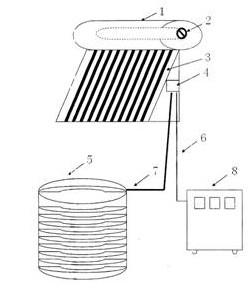(单词翻译:单击)

Science and Technology
科技
Solar heat for oil wells
用于油井的太阳热能
Mirrors in glasshouses…
温室的反光镜…...
…can be used to heat stones
…...能用于加热石头
THERE is a lot of energy from ancient sunshine stored in the oil that sits below the deserts of Oman.
古代阳光的很多能量储存于埋藏在阿曼沙漠下的石油里。
There is also a lot of sunshine hitting those deserts today.
如今,还是有很多阳光照射在这些沙漠之上。
A new wrinkle to an established technology should allow some of that current sunshine to be employed to get at more of the ancient stuff.
不过,一项已确定的技术革新应该允许那部分如今的阳光能被用于从古老的原料中提取到更多东西。
Using heat—in the form of steam—to liberate disobligingly thick and gunky oil which would otherwise stay in the ground is nothing new.
运用热能---以蒸汽的形式---来释放(放出)不方便使用的浓厚而黏稠状的石油,否则这些石油会留在地下,这没什么新鲜的。
Such enhanced-recovery techniques date back to the 1950s and 40% of California's oil production now depends on steaming subterranean rocks in this way.
这类提高的采收石油技术可以追溯到20世纪50年代。现如今,40%的加州石油产品就是以这种方式依赖热气腾腾的地下岩石生产而成。
The steam, however, is made by burning other fossil fuels—normally natural gas—and because heating rock takes a lot of steam, making that steam takes a lot of money.
然而,通过燃烧其它化石燃料来生产蒸汽---一般为天然气---而因为加热岩石需要很多蒸汽,所以生产蒸汽花费很大。
It also adds to the oil's climate footprint.
它还增加石油的(气候变化)的碳排放量。
The amount of gas used means that a barrel of Californian heavy oil gives the stuff from Canada's tar sands a run for its money in terms of associated greenhouse-gas emissions.
根据相关的温室气体排放量,天然气的耗费量意味着每桶加州重油竭尽全力打败了加拿大沥青砂岩中提取的原油。
GlassPoint, a small Californian company, thinks it can make steam for oil recovery more cleanly and cheaply by using sunshine to do the heating.
加州的一家小公司---玻璃点太阳能公司认为,通过使用阳光来加热,它能为采油生产更清洁和更便宜的蒸汽。
This sounds surprising.
这听起来令人感到意外。
Solar-thermal power stations, which employ mirrors to concentrate sunlight on boilers and thus raise steam to generate electricity by turning turbines, are far from cheap compared with gas-fired stations.
太阳能热发电站利用反光镜将太阳光集中到锅炉上,因而提升蒸汽转动涡轮机来产电,与燃气站相比一点也不便宜。
But solar-thermal electricity faces exacting challenges.
然而,太阳能热发电面临严峻的挑战。
To feed a turbine you need particularly pure steam, which can be a problem if you are in a desert.
为了给涡轮机提供特别需要的纯蒸汽,如果在沙漠里的话,这可能是个问题。
And to get the most out of the system you need the steam to be both very hot indeed and available in copious amounts.
而且为了从这个系统中得到最多,确实需要非常高温的蒸汽而且要用的量很大。
Oil wells, GlassPoint's founders noticed, are far less demanding consumers in these respects.
玻璃点太阳能公司的创始人注意到,在这些方面,油井是要求少的多的消费者(消耗者)。
The steam used can be comparatively dirty.Nor does it have to be infernally hot.
相比之下,使用的蒸汽可以脏些,温度也不需要过高。
And even a small amount of it, added to an existing gas-based recovery process, can make a useful contribution.
而且,甚至添加少量的蒸汽到现有的以天然气为基础的采油过程也能产生作用。
There are, though, disadvantages to having to work in an oilfield.
虽然,如果必须在油田运用蒸汽的话,确实有些不利条件。
People building solar-thermal power stations prefer sites low in dust.
人们喜欢在粉尘量低的位置建造太阳能热发电站。
Those serving the oil industry must go where the rigs are, however dusty and mucky the air.
无论空气尘土多大,多么肮脏,为石油工业服务的人们必须跟随钻井走。
GlassPoint seems to have found a neat solution to this: it puts its mirrors indoors. Greenhouses are easy to buy, quick to erect and, thanks to off-the-shelf kit designed for the purpose, simple to keep clean, too.
玻璃点太阳能公司似乎已经为此找到了一套干净利落的方案:把反光镜放在室内。由于为建温室目的而设计现成的成套用品,人们很容易购买到温室,很快就能建造起来,而且保持清洁也很简单。
Moreover, sheltering the mirrors from the wind allows those mirrors to be a lot lighter, making them both cheap to build and ship, and easier to turn in order to follow the sun.
此外,为保护反光镜免受风的侵蚀,准许这些反光镜重量要轻的多,使得它们既建造便宜也容易运输,而且为了跟进太阳而更容易转向。
GlassPoint's boss, Rod MacGregor, thinks that taking capital costs and the lifetime of the plant into account his firm can produce steam at $3.78 per million British thermal units (btu), which is $3.58 a gigajoule.
玻璃点太阳能公司的老板罗德?麦格雷戈(Rod MacGregor)认为,考虑到工厂的资金成本和历史,他的公司能产生蒸汽每百万英(制)热单位(BTU)3.78美元,这是每千兆焦耳3.58美元。
Steam from gas comes in at $5.79 per million btu.
天然气加热的蒸汽达到每百万英(制)热单位(BTU)5.79美元。
A pilot project in California, he says, has been producing steam as intended since the beginning of the year.
他说,自年初以来,加州一个实验项目已经产生了预期的蒸汽。
And the company has now signed a deal with Petroleum Development Oman for 7 megawatts of plant—a 16,000-square-metre greenhouse providing some 57 billion btu of steam a year.
而且该公司现在已经与阿曼石油开发公司签署了7兆瓦工厂的协议---一个16000平方米的温室,每年大约提供570亿百万英(制)热单位(BTU)的蒸汽。
If it pans out, the technology could spread fast.
如果这个实验项目发展开来的话,那么这项技术可能会传播很快。
Mr MacGregor expects Oman to be using 200 trillion btu of steam a year for oil recovery by 2015.
麦格雷戈先生预计,到2015年为止,阿曼石油开发公司每年可以使用200万亿每百万英(制)热单位(BTU)蒸汽来开采石油。
Not all of that steam could be solar, but a system which used high-pressure solar steam during the day and low-pressure gas-generated steam by night, to keep the pipes hot, might get 80% of its power from the sun.
并非所有的蒸汽来自太阳能,而是来自一个系统。白天,这个系统使用高压太阳蒸汽,而晚上使用低压天然气产生的蒸汽,保持管道热乎,或许80%能量可从太阳光获得。
That would free up a lot of gas for export—or for turning into petrochemicals.
这将可以得到很多天然气用于出口---或用于转变成石油化学制品。
Enhanced oil recovery currently uses a quite remarkable amount of energy: 1.7 quadrillion btu of gas around the world every year, according to GlassPoint.
目前,提高石油开采使用相当大的能量:根据玻璃点太阳能公司所述,每年,世界各地需要使用1.7×1015每百万英(制)热单位(BTU)的天然气。
Not all of that is in sunny places, but there are many deserts besides Oman's that have oil beneath them.
并不是所有天然气都在阳光充足的地方,但是,除了阿曼沙漠下面有石油外,许多沙漠下都有石油。
The paradoxical possibility, then, is that solar-thermal technology might end up producing a lot more oil than electricity in the years to come.
然而,自相矛盾的可能性是,在未来几年里,太阳能热技术最终可能生产许多石油,而不是电。


